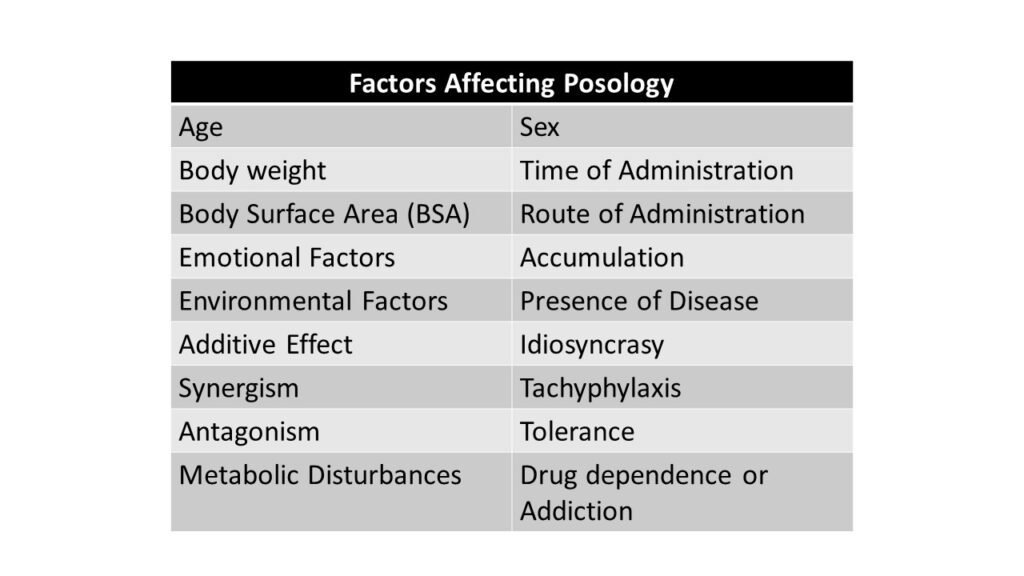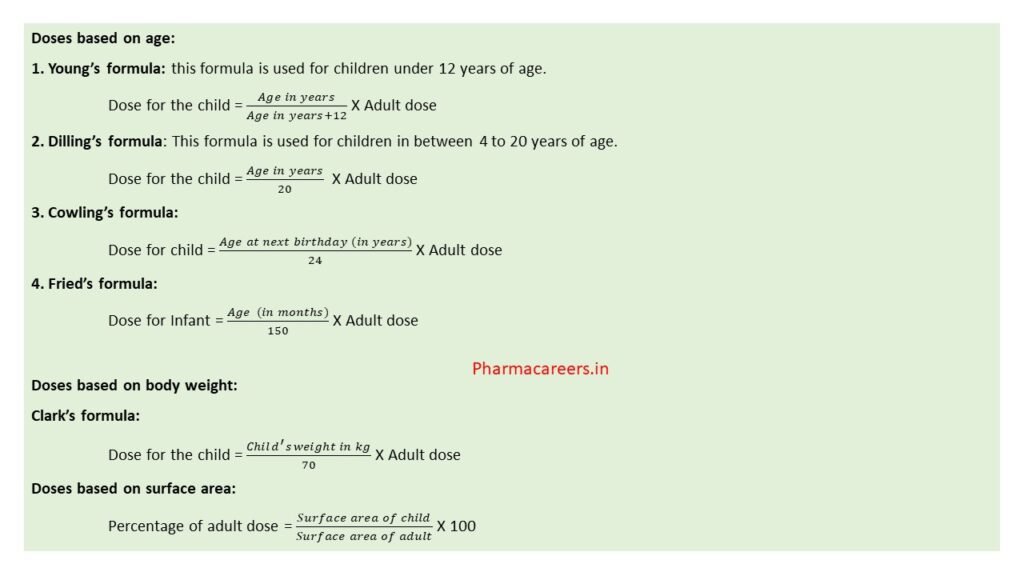Posology
Posology is a branch of medical science which deals with dose or quantity of drugs which can be administered to a patient to get the desired pharmacological action. The word posology is derived from the Greek words ‘posos’ meaning how much and ‘logos’ meaning science. In this article we will see the various factors affecting the posology and some formulas to calculate dosage of medicines.
Factors affecting posology (dose)
Dose: It is the amount of drug administered or consumed by a patient in order to get the desired pharmacological action. There are various factors which affects the calculation of doses.
- Age
- Sex
- Body weight
- Time of administration
- Body surface area
- Route of administration
- Emotional factors
- Accumulation
- Environmental factors
- Presence of disease
- Additive effect
- Idiosyncrasy
- Synergism
- Tachyphylaxis
- Antagonism
- Tolerance
- Metabolic disturbance
- Drug dependence or addiction

Age
Human beings can be categorized in following age groups:
- Neonate: From birth up to 30 days.
- Infant: Up to 1 year age.
- Toddler: 1 to 4 years.
- Child: 5 to 12 years.
- Teen: 13 to 19 years.
- Adult: 20 to 59 years.
- Geriatric: more than 60 years.
In children the hepatic and renal functions are not fully developed, which affects the detoxification and elimination of drugs from the body. Hence all the doses for children are less compare to adults. To calculate dose for children they are categorised in three age groups, 2-6 years of age, 6-12 years of age, and children of 12 years.
In geriatric patient metabolism and elimination of drugs from body is slowed due to loss in renal and hepatic functions. It increases the chances of drug accumulation in tissues. Some drugs like hypnotics develop confusion in geriatric patient due to their sedative effect.
Sex
Drugs mechanism of action for men and women are same, but there is difference how they respond to drug. For example, it takes long time for women to response to sedative drugs like morphine, barbiturates.
Women goes through menstruation, pregnancy, lactation. Special care should be taken in these periods while administering drugs. Strong purgatives, antimalarials, and ergot alkaloids should not be given in pregnancy. Sedative drugs should not take during breast feeding, these drugs get secreted in milk.
Body weight
The dose of drug administered according body weight is mentioned as milligrams per kilogram of body weight (mg/kg).
This technique is used for people having body weight between 50-100 kg.
For the people who are malnourished, thin or obsessed, dose is adjusted as per their body weight. This is the most common factor to calculate dose for children.
Time of administration
The time administration plays an important role to decide the effectiveness of the drug. Drugs get absorbed rapidly in empty stomach; the absorption of drugs get reduce in the presence of food. Every drug acts differently, according to its action with food, its time of administration is decided. For example, iron arsenic and cod liver are taken after meal and antacids are given before meal.
Body surface area (BSA)
For the adult dose calculation, the average weight is considered 70kg. This may not be correct for very obese or very lean person. So, body weight alone is not accurate for dose calculation. In such cases dose of a patient is calculated based on body surface area. Average adult body surface area is 1.73m2.
Body surface area = Adult dose X BSA of child (in m2)/1.73 m2
| Sr. No. | Body weight (kg) | BSA (m2) |
| 1 | 1 | 0.10 |
| 2 | 3 | 0.16 |
| 3 | 5 | 0.30 |
| 4 | 7 | 0.38 |
| 5 | 9 | 0.46 |
| 6 | 10 | 0.49 |
| 7 | 12 | 0.56 |
| 8 | 15 | 0.65 |
| 9 | 20 | 0.79 |
| 10 | 25 | 0.92 |
Route of administration
Bioavailability of the drug changes as route of administration changes. Drugs administered by intravenous (IV) route are more bioavailable than that of orally administered drugs. IV administered drugs are directly injected into the bloodstream; hence they show immediate effects after administration. Orally administered drugs takes time for dissolution, absorption and hence comparatively they tale more time to show effects.
Emotional factors
Response of drug can be altered by emotional state of a patient consuming the drug. Strong belief of patient towards drug increases its efficacy. Placebo is an inert substance, which does not have any therapeutic or toxic property. Placebos are used in clinical trials to attain some psychological effects. Most commonly used placebos are lactose tablet and distilled water injections. Placebo effects are achieved in angina and asthma patients successfully.
Accumulation
If the rate of drug absorption from body is higher than that of elimination, there are chances of drug accumulation in body. Accumulation of drugs produces toxic effects and can be fatal. Drugs like digitalis and heavy metals show toxic effects upon accumulation.
Environmental factors
Hypnotic and sedative drugs are more effective if administered at night. Darkness at night increases the efficacy of sedatives. Barbiturates and benzodiazepines require higher dose if given at day time. CNS stimulants requires higher dose at night as compared to day time.
Presence of disease
Dose of the patient changes, patient has certain disease. For example, absorption of aspirin decreases in patients suffering from achlorhydria, hence require higher dose. This drug-disease interaction can be fatal in some cases. Antibiotic streptomycin is eliminated via kidney. CKD (chronic kidney disease) patients consuming streptomycin are at high risk of kidney failure.
Additive effect
When therapeutic action (TA) of two drugs (administered simultaneously) is equal to their separate action, this phenomenon is known as additive effect. For example, ephedrine and aminophylline used in asthma treatment shows additive effect.
TA of drug A + TA of drug B = TA of AB
Idiosyncrasy
Some patients show abnormal response to a drug other than its actual therapeutic use. Idiosyncrasy also termed ass allergy. For example, skin rashes due to penicillin, gastrointestinal haemorrhage due to aspirin etc.
Synergism
When to or more drugs are used in combination therapy, they show enhanced therapeutic action than their individual effect, this phenomenon is known as synergism. This is also called as potentiation. Synergism is used when a single drug is unable to achieve desired therapeutic effect. For example, levodopa and carbidopa are administered simultaneously, their combined effect is elevated.
TA of drug A + TA of drug B < TA of drug AB
Tachyphylaxis
When a particular drug is administered repeatedly, receptors of the drug get blocked and therapeutic action of drug is reduced. Tachyphylaxis is also known as acute tolerance. This can be reversed by increasing dose of a drug. For example, repeated administration of ephedrine in bronchial asthma reduces its therapeutic effect.
Antagonism
When two drugs are administered together and therapeutic action of one drug is opposed by another, this phenomenon is known as antagonism. That means one drug neutralizes the therapeutic action of another drug. This method is useful in neutralizing poisoning effects. For example, acid poisoning is treated with alkaline substance milk of magnesia.
Tolerance
When a particular drug is repeatedly used for longer duration of time tolerance is developed by the body. Tolerance is the ability of a drug to withstand therapeutic action. Hence higher dose of the drug is required to achieve the TA. For example, nicotine requires in high dose for smoker patients. Tolerance can be natural, acquired or cross tolerance.
Metabolic disturbance
Metabolism of body may affect on the activity of drug. Which means drug shows its optimum effect in presence of certain physiological factors (such as body temperature, acid base balance). For example, salicylates reduce body temperature to normal only if person has rise in body temperature. Otherwise, salicylates do not have any antipyretic activity.
Drug dependence or addiction
Addiction is a complex condition where a person has a compulsive and uncontrollable desire to use a specific substance, despite knowing the harmful consequences. It may be physical or psychological dependence.
Physical dependence: tea, nicotine.
Psychological dependence: marijuana, opiates.
Calculation of Doses
The dose of drugs is calculated in proportionate to age, body weight and surface area of the patient.

For more regular updates you can visit our social media accounts,
Instagram: Follow us
Facebook: Follow us
WhatsApp: Join us
Telegram: Join us
